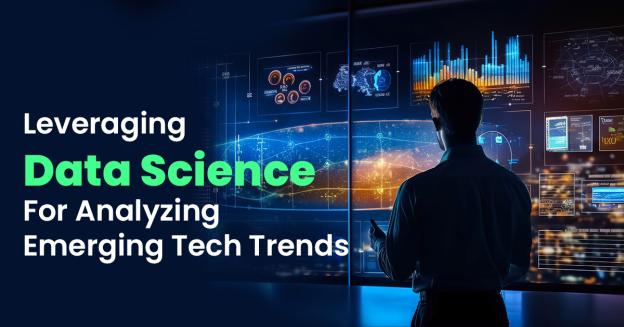In the fast-paced world of technology, staying ahead of emerging trends is crucial for businesses and professionals alike. From the rise of artificial intelligence to the blockchain revolution, the landscape is constantly evolving. This is where Data Science steps in as a powerful tool for analyzing and understanding these shifts. Whether you’re considering a Data Science Courses or looking to enhance your knowledge, the ability to leverage data science techniques can provide invaluable insights into emerging tech trends.
Introduction
In today’s era of rapid technological advancements, the need to stay abreast of emerging trends has never been more critical. Industries across the globe are witnessing transformative changes fueled by innovations in artificial intelligence (AI), machine learning (ML), blockchain, Internet of Things (IoT), and more. These technologies are reshaping business landscapes, revolutionizing customer experiences, and driving unprecedented growth opportunities.
For professionals and businesses alike, understanding these emerging tech trends is not just advantageous; it’s a necessity for survival and success in the competitive market. This is where the field of Data Science emerges as a beacon of insight. The ability to harness the power of data through sophisticated analytics and predictive modeling opens doors to a wealth of knowledge about current and future tech trends.
Whether you’re a seasoned data scientist or considering embarking on a data science course, the applications of this field in analyzing emerging tech trends are vast. Let’s delve into how Data Science can be leveraged effectively to decode the complexities and opportunities of the ever-evolving tech landscape.
Understanding Data Science’s Role in Tech Trend Analysis
What is Data Science?
At its core, Data Science is the field that encompasses the extraction of knowledge and insights from large volumes of data. It combines elements of statistics, machine learning, programming, domain expertise, and data visualization to make informed decisions and predictions.
Why Data Science for Tech Trend Analysis?
Emerging tech trends often leave a trail of digital footprints—vast amounts of data generated from user interactions, online activities, sensor readings, and more. Data Science provides the tools to collect, process, analyze, and interpret this data, unveiling patterns and insights that reveal the trajectory of these trends.
Uncovering Patterns with Data Science
Data Science techniques such as machine learning algorithms, natural language processing (NLP), and deep learning play pivotal roles in identifying patterns within data. For instance, in the realm of social media, sentiment analysis using NLP can reveal public opinions and reactions to new tech products or services. This information is invaluable for companies seeking to understand market reception and potential success.
Predictive Modeling for Future Insights
One of the most powerful aspects of Data Science is its ability to predict future trends based on historical data. By building predictive models using algorithms like linear regression, decision trees, or neural networks, analysts can forecast the growth trajectories of emerging technologies. This foresight enables businesses to make informed decisions, allocate resources strategically, and capitalize on upcoming opportunities.
Utilizing Data Science Tools and Techniques
Big Data Analytics
The vast amounts of data generated by emerging technologies require scalable and efficient analytics tools. Data Science leverages technologies such as Apache Hadoop, Apache Spark, and cloud-based platforms like Amazon Web Services (AWS) and Google Cloud Platform (GCP) to process and analyze big data sets.
Machine Learning Algorithms
Machine learning lies at the heart of many data science applications. Supervised learning algorithms, such as support vector machines (SVM) or random forests, can classify trends and make predictions based on labeled data. Unsupervised learning algorithms, like k-means clustering, help identify hidden patterns and groupings within data sets.
Natural Language Processing (NLP)
With the proliferation of textual data from social media, forums, news articles, and reviews, NLP techniques become invaluable. Sentiment analysis, topic modeling, and entity recognition are just a few examples of how NLP can extract insights from unstructured text data related to emerging tech trends.
Network Analysis
In the interconnected world of technology, network analysis tools can reveal the relationships between entities such as companies, products, or technologies. By analyzing networks, Data Scientists can identify influential players, emerging collaborations, and potential disruptors within the tech landscape.
Case Studies: Analyzing Emerging Tech Trends
1. AI and Automation in Healthcare
Data Science has played a pivotal role in analyzing the adoption and impact of AI and automation in healthcare. By analyzing patient records, medical imaging data, and clinical trial results, researchers can predict disease progression, personalize treatment plans, and optimize healthcare delivery.
2. Blockchain and Cryptocurrency Trends
The blockchain revolution has spurred a wave of innovation, with Data Science providing insights into cryptocurrency adoption and market trends. Analysis of blockchain transactions, trading volumes, and social media discussions can reveal investor sentiments, market volatility, and emerging use cases for blockchain technology.
3. IoT and Smart Cities
The Internet of Things (IoT) is transforming urban landscapes into interconnected smart cities. Data Science techniques enable city planners to analyze sensor data from traffic, energy usage, public transportation, and environmental factors. This analysis guides decisions on infrastructure development, resource optimization, and improving overall quality of life.
Challenges and Opportunities Ahead
As Data Science continues to evolve, several challenges and opportunities emerge on the horizon:
Data Privacy and Security: With the abundance of personal and sensitive data involved in tech trend analysis, ensuring robust data privacy measures and cybersecurity protocols is paramount.
Interdisciplinary Collaboration: The complexity of emerging tech trends often requires collaboration between Data Scientists, domain experts, engineers, and policymakers. Interdisciplinary teams can harness diverse perspectives to derive deeper insights.
Real-Time Analytics: The need for real-time insights into rapidly evolving tech trends calls for the development of agile analytics frameworks and streaming data processing techniques.
Ethical AI: As AI algorithms drive decision-making processes, ensuring fairness, transparency, and accountability in AI systems becomes crucial. Ethical frameworks and guidelines must be integrated into tech trend analysis practices.
Conclusion
In the ever-evolving landscape of technology, Data Science stands as a beacon of insight, guiding businesses and professionals toward a deeper understanding of emerging trends. Whether you’re considering a Data Science Course or already immersed in the field, the applications of Data Science in tech trend analysis are boundless. From uncovering hidden patterns to predicting future trajectories, Data Science techniques empower us to navigate the complexities of emerging technologies with confidence.
As we embrace the opportunities and tackle the challenges of this digital frontier, the role of Data Science in analyzing emerging tech trends will only grow in importance. By harnessing the power of data, we pave the way for innovation, strategic decision-making, and a future shaped by the transformative forces of technology.






